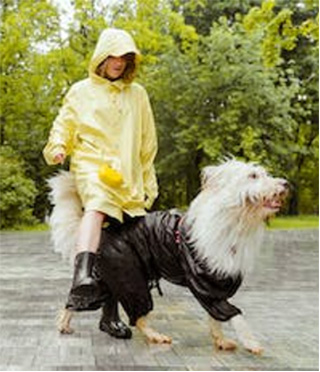Ears & Rears – Would it Ever End?
Itchy Ears & Body – Where does it End?
Poking my head into the reception room, my gaze fell on a nicely groomed Old English Sheepdog – my next patient. As I invited her and her person into the exam room I noticed a slight left head tilt. Her gait was normal, with no tendency to veer to one side. An ear infection seemed more likely than a neurologic cause but I would also check her teeth. Shaking the hand of my new client I was stuck by this lady’s quiet confidence. Her name was Miss Manners – really, that was her name.
We learn a lot about pets by watching them move. Thorough medicine means we miss nothing, including signs of even mild pain. I observe by trying to be inconspicuous, like a fly on the wall wearing a white coat.
“Chase” was 3 years old and had been suffering from an on-again, off-again left ear infection. Was she itchy? Oh yes, she’d been scratching pretty much everywhere for the past year, since their move to New Mexico.
I do my best work in good light, examining at chest level, even with a big dog. I explained that I would fetch nurse Amos to help me heft this big fuzzy girl onto the table. My well-dressed client stated courteously but unequivocally that she would help and hold her pet. Adopting my most inscrutable expression I lifted Chase’s front end (heavier because heads weigh more than rumps) while Miss Manners deftly managed the rear. Impressive.
An Old English Sheepdog is a gorgeous creature but masquerading as Cousin Itt carries real drawbacks. I parted the long silver and white hairs in several areas, noticing skin that was pink from inflammation and self-injury. We were only getting started.
Showered in Discharge on the Way to Ear Redemption
Miss Manners did a fine job of holding “Chase” on the exam table. After evaluating this big shaggy dog’s skin I examined her teeth and gums. Finding no pain or swelling I moved North. Peering at me through a thick mop of hair were a pair of bright and healthy peepers. Those ears, well, they told a different story.
By some estimates ear infections are the most common problem seen by veterinarians, often smoldering for months. Heavily haired flaps can easily obscure redness, discharge, and a yeasty odor.
Our dogs love us. When we’re home with them they watch for opportunities to earn play, affection, and food. It’s after we leave that they focus more on what’s bothering them. They scoot, rub, dig, and lick at those unhappy places believing that we’ll never know. If you make the mistake of scolding your dog for fidgeting, they learn not to – when you’re in the same room.
I carefully slid my otoscope into each of Chase’s ear canals and was greeted by a prodigious quantity of sticky beige discharge. Her attentive dog mamma had noticed the raunchy smell during a recent home grooming. This girl needed help.
A dab of discharge, gram-stained and viewed under the microscope, revealed a veritable army of yeast and bacteria. No surprise. I retrieved a towel, a kidney-shaped basin, an ear syringe, and dilute disinfectant. And then I asked Miss Manners if she still wanted to hold her big hairy dog and risk being showered by disinfectant and hunks of ear debris when the inevitable head shaking erupted. Of, course, she was game.
I slung a big thick towel over Chase’s head and gently irrigated her unhappy ear canals. When we finished I resembled a drowned rat but my client was miraculously unscathed. We call that success. I prescribed ear medication and, for all that itching, an antihistamine. This pupster needed to feel better if she was going to get better; it doesn’t take a lot of scratching and scraping to damage skin and ears and rears.
Ears and Rear – No End in Sight
We’d put an end to those ear infections, whatever it took, but unless we controlled Chase’s scratching and rubbing, the population of normal organisms in her ears would explode all over again. And then we had those odious anal glands. This sweet girl’s name was Chase but it could have been “Rubber” or “Scooter.”
Allergies in dogs are often caused by airborne pollens, molds, and house dust mites. Veterinary dermatologists believe this unseen assault occurs more by skin penetration that by inhalation. I could have suggested an air filter mask for Chase but she’d benefit more from a daily moist towel wipe-down. Anti-itch medications would also help.
Way back in veterinary school I rode a motorcycle, partly because I couldn’t afford a car but also because I was a thrill seeker. Becoming a family man cured me of that but I remember one event that taught me empathy for the rear end maladies of the pets I was learning to treat.
One crazy hot and humid summer day I was doing 75, zipping along I-96 in Michigan, when I noticed an unpleasant sensation. The saddle of my Triumph Bonneville was veritably frying my rump. As I skidded onto the shoulder it became immediately clear that the canvas bags holding my cloths had slipped, and now resting on the muffler, had caught fire. I was in the hot seat. An undying empathy for rear end disordered pets was formed that day.
Even in a busy veterinary practice we have an occasional quiet day with time for a little friendly banter. I shared this narrative with Amos but rather than receiving these deep thoughts with a sympathetic ear, he reacted was such hysterics that I feared he would embarrass himself. No respect. I had a mop handy just in case.
On follow-up a week later Miss Manners reported Chase rubbing her head somewhat less but the poor dog’s scooting continued. My otoscopic exam revealed less ear discharge but the redness in her canals persisted. A digital rectal exam brought her anal glands into sharp focus: another victim of her allergies. I felt her pain. Ears and rears. Antibiotics were started; sedation to irrigate those vestigial nuisances was scheduled – soon.

Facing the Rear – What’s Back There?
Beyond her side scratching, paw licking, and head rubbing, Chase was a serious scooter on her painful derriere. I sedated the big girl, thoroughly irrigated her ears, and manually emptied her two angry, pus-filled anal glands.
Consider yourself and your pets fortunate if you’ve never heard of anal glands. Standard equipment on all dogs and cats, these two cesspools of bacteria live beneath the skin at the 4 o’clock and 8 o’clock positions relative to the anus. I know how gross this is; I hope you’re not trying to enjoy breakfast as you digest this information.
Anal glands serve no useful purpose in our pets although for skunks, their very distant relatives, the revolting fluid produced inside them serves as a defensive weapon.
I irrigated Chase’s anal glands and infused them with an antibiotic/antiinflammatory ointment. We sent her home with pain meds and encouraged Miss Manners to continue at-home ear treatments. There was no doubt we would succeed in improving this special dog’s quality of life but the journey was becoming a long and winding road.
Healthy ear canals, with no history of self-trauma or infection, are a truly beautiful thing. The walls are smooth, pale pink, and shiny. Chronic ear infections, on the other hand, create permanent anatomic changes. They can get thick and bumpy enough on the inside to cause deafness. Multiple nooks and crannies develop where organisms set up permanent housekeeping. I wasn’t willing to leave the door open for one more flare-up for this good girl.
Challenging cases make us better doctors but pet parents want results. If our patient didn’t turn the corner soon I would recommend the nuclear option: surgery – at both ends.
On our next follow-up it was clear that Chase’s ears could not evict their nasty residents without a course change. It was time to bring sunshine and fresh air into the picture. Her anal glands? If they didn’t straighten up and fly right, pretty quickly, they would need to go.

It all Came Out Fine in the End
Most of us would rather file our knuckles with a cheese grater than face surgery but Chase, the full-body itching Old English sheepdog, was running out of options. I infused her chronically infected anal glands and irrigated her ears one more time during her next follow-up, all the while managing her allergies with at-home medication.
Anatomy evolves to promote survival of a species but that doesn’t make it friendly to modern medicine. Dogs’ ears have a long vertical canal that makes an “L” shape with the horizonal portion. With lots of damage to all that tubing, from scratching and head shaking, Chase harbored a dark, warm, moist environment that defied a cure. We could have continued our relentless flushing and medicating but we’d be running in place for the rest of her life. Her unhappy anal glands had a similar prognosis. She needed a better future.
I gave my client, the ever patient Miss Manners, the options and recommended a plan. She wanted only the best for her dog and got on board. We had Chase on the operating table 2 days later for a La Croix-Zepp procedure on each ear. Her remodeled vertical canals would stay permanently open and dry, very likely (no guarantees in medicine) never facing another infection. She needed gentle moist compresses at home, pain medication, and a cone-shaped collar to allow healing. Both ear surgery sites came along nicely.
Chase was tough, ready for the last phase. I administered a second anesthesia 2 weeks later, removed both of her anal glands, and securely stitched her incisions. After more pain meds and another stint with the warm compresses and collar, her constant burning sensation evaporated. I remember squinting through a magnifying loop 10 days later as I nipped each suture out of her backside. Not a pleasant task but necessary.
It was 1991; we didn’t have powerhouse anti-itch drugs like Atopica and Cytopoint yet but our veterinary dermatologist was able to tailor an injection series, along with antihistamines, that reduced Chase’s scratching to a tolerable annoyance. Her ears and rear were finally happy and, equally important, so was her person.




